Intercropping of grain legumes with cereals
(Швейцария)
Mischkultur von Körnerleguminosen und Getreide
Описание
Intercropping of grain legumes with cereals is a sustainable agricultural practice in Swiss farming. This involves growing grain legumes (such as peas or beans) alongside cereal crops (like barley or wheat) in the same field, reducing crop failure or yield risk, stabilising the grain legumes, promoting biodiversity and enhancing overall crop yield.
Intercropping of grain legumes with cereals is practised in the Broye catchment area, which covers the cantons of Vaud and Fribourg in Switzerland. The area is characterised by mixed dairy and arable production in the hills and predominantly arable production in the lowlands. The area has an average annual rainfall of 865 mm, an average temperature of 9.6°C and significant agricultural activity relies on irrigation from local rivers.
Intercropping is the simultaneous cultivation of two or more crops in the same field. In this case, grain legumes (such as peas, lupins or faba beans) are grown alongside cereals (such as barley, oats or wheat). The crops are sown together in a pre-prepared mixture, usually at a ratio of 65% legumes to 35% cereals by weight, compared to the standard weight sown in monoculture (100%). The seeds are fully mixed and sown in the same row. Crops are grown over the winter and harvested simultaneously in the spring, which requires compatible combinations whose breeding is continuously optimised for simultaneous ripening. The standard practice in Switzerland is to use a cereal plus a legume.
The main purpose of intercropping grain legumes with cereals is to increase ecological resilience and improve soil fertility. Including legumes in rotations significantly improves soil nitrogen levels, reducing the need for synthetic fertilisers. Intercropping also increases water infiltration, reduces runoff and increases biodiversity. The increase in biodiversity is small in terms of the overall biodiversity of agricultural land (e.g. soil micro-organisms, pollinators). The number of crops grown remains relatively constant. The practice aims to produce higher yields on a given piece of land by using resources that would otherwise not be used by a single crop. The overall yield is higher, although land equivalent ratios (LER) were not measured in this study. However, a cited paper (Chapagain & Riseman, 2014) shows that intercropping barley with peas can increase land productivity by 12-32% compared to monoculture plots, with a 2:1 arrangement producing the highest total land outputs and LER values.
Establishing and maintaining intercropping requires several key activities and inputs: (1) Use of tractors and seed drills for planting and harvesting intercrops. (2) Regular weeding, especially in fields with crops such as soy. (3) Episodic irrigation with water from local irrigation syndicates. (4) Minimal use of fertiliser and homemade manure to maintain soil health.
Intercropping has many benefits: (1) Increases biodiversity, improves soil fertility and increases water infiltration. (2) Reduces the need for synthetic fertilisers, making it economically viable for farmers. (3) Improves drought resistance and reduces the risk of crop failure. (4) Contributes to better water management and resilience to climate change. (5) Surface erosion is reduced by the greater cover of mixed crops (leaf area index).
Farmers appreciate the effectiveness of intercropping in achieving yields similar to monocultures, while adding the benefits of cereals. They also value the reduced need for synthetic fertilisers and improved soil health. However, challenges include seed selection and segregation, particularly for crops such as wheat and faba beans, and weed management in certain fields.
Местоположение
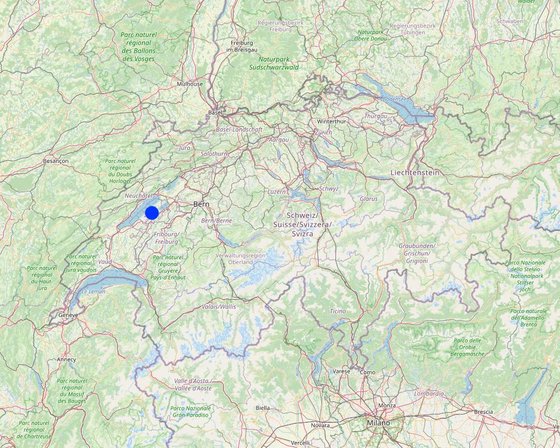
Местоположение: Missy / Vaud / Switzerland, Швейцария
Число исследованных участков, где применяется Технология: отдельный участок
Географическая привязка выбранных участков
Пространственное распространение Технологии: равномерно-однородное применение на определенной площади
На постоянно охраняемой территории?: Нет
Продолжительность применения Технологии: 10-50 лет назад
Тип внедрения/ применения
-
как инновация (инициатива) землепользователей
-
как часть традиционной системы землепользования (более 50 лет назад)
-
в качестве научного/ полевого эксперимента
-
через проекты/ внешнее вмешательство
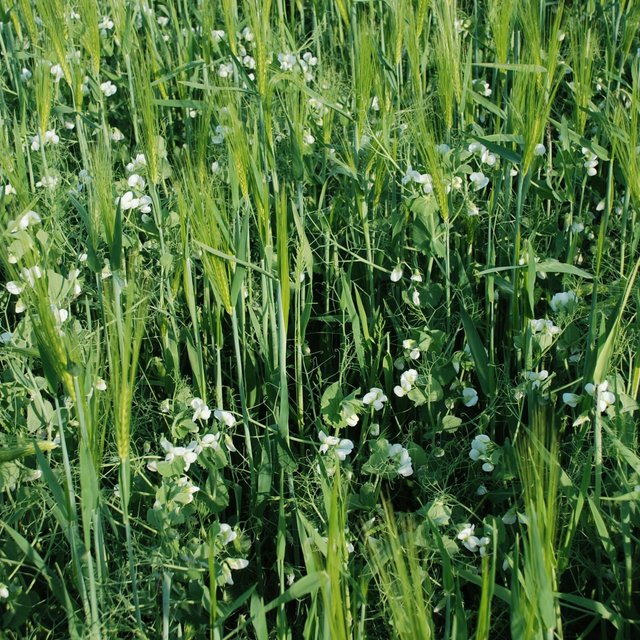
Intercropping of peas and barley in spring (Hansueli Dierauer (FiBL))
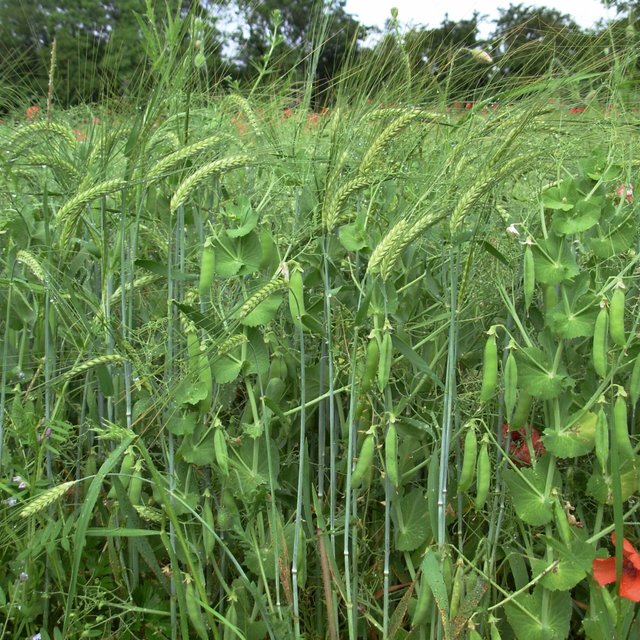
Mixed intercropping of pea and barley in summer (Cornelia Kupferschmid (FiBL))
Основная цель
-
повышение производства
-
снижение или предотвращение деградации земель, восстановление нарушенных земель
-
сохранение экосистем
-
защита бассейнов рек (приводораздельной части/ нижнего течения) – в сочетании с другими Технологиями
-
сохранение/ повышение биоразнообразия
-
снижение риска стихийных бедствий
-
адаптация к изменению климата / экстремальным погодным явлениям и их последствиям
-
смягчение последствий изменения климата
-
создание благоприятных экономических условий
-
создание благоприятных социальных условий
Землепользование
Комбинированное землепользование в пределах одной и той же земельной единицы: Нет
-
Пахотные угодья и плантации
- Однолетние культуры: зерновые культуры - ячмень, зерновые культуры - овес, бобовые - другие, бобовые - зеленый горошек, Lupine (legume)
Число урожаев за год: 1
Применяются ли посевы в междурядьях? Да
Применяется ли севооборот? Да
Водоснабжение
-
богарные земли
-
сочетание богарных и орошаемых земель
-
полное орошение
Цель, связанная с деградацией земель
-
предотвращение деградации земель
-
снижение деградации земель
-
восстановление/ реабилитация нарушенных земель
-
адаптация к деградации земель
-
не применимо
Тип деградации, на борьбу с которым направлена
-
водная эрозия почв - ВЭп: поверхностная эрозия/смыв верхних почвенных горизонтов
Категория УЗП
-
Улучшение почвенного/ растительного покрова
-
Комплексное управление почвенным плодородием
-
улучшение сортов растений/ пород животных
Мероприятия УЗП
-
Агрономические мероприятия - A1: Растительный/ почвенный покров, A2: Органическое вещество/ почвенное плодородие, A5: Семенное хозяйство, селекция, применение улучшенных сортов
Технический рисунок
Технические характеристики
The illustration shows a field where peas and barley are grown together in a mixed cropping system. The plants with rounded leaves and tendrils are peas, while the taller plants with linear leaves are barley. The interviewed farmer typically grows these crops on an area of two to three hectares. The mixed crops are at an advanced stage of growth, several weeks before harvest, with both pea and barley producing seed. The rooting depth of the pea plants can reach up to 110 centimetres, while the barley plants can extend their roots up to 150 centimetres under optimal conditions.
These plants grow on brown soil composed of three main horizons. Horizon A is usually brownish in colour and extends to a depth of over 20 cm. It is rich in organic matter and mineral particles, making it biologically active with many soil organisms and plant roots. The B horizon is lighter in colour and typically extends from about 20 cm to 150 cm deep. It contains minerals leached from the A horizon and shows signs of weathering, with a more defined structure due to the accumulation of minerals and organic matter from the upper layers. The C horizon, or parent material, lies below the B horizon and extends beyond 150 cm. It consists of partially disintegrated and weathered parent material, is typically lighter in colour than the B horizon and has minimal biological activity compared to the upper layers.
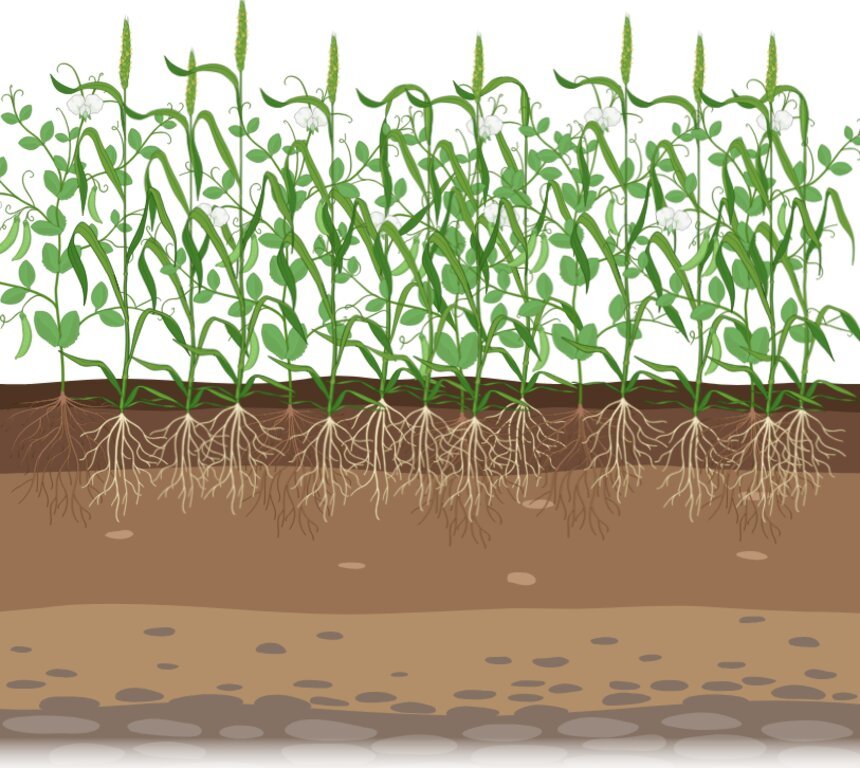
Author: Basile Brunner (UniBE)
llustration of benefits of intercropping for crop resilience and crop yields, management of soils, weeds, pests, and pathogens, along with environmental benefits of carbon sequestration and reduction of fossil fuel inputs.
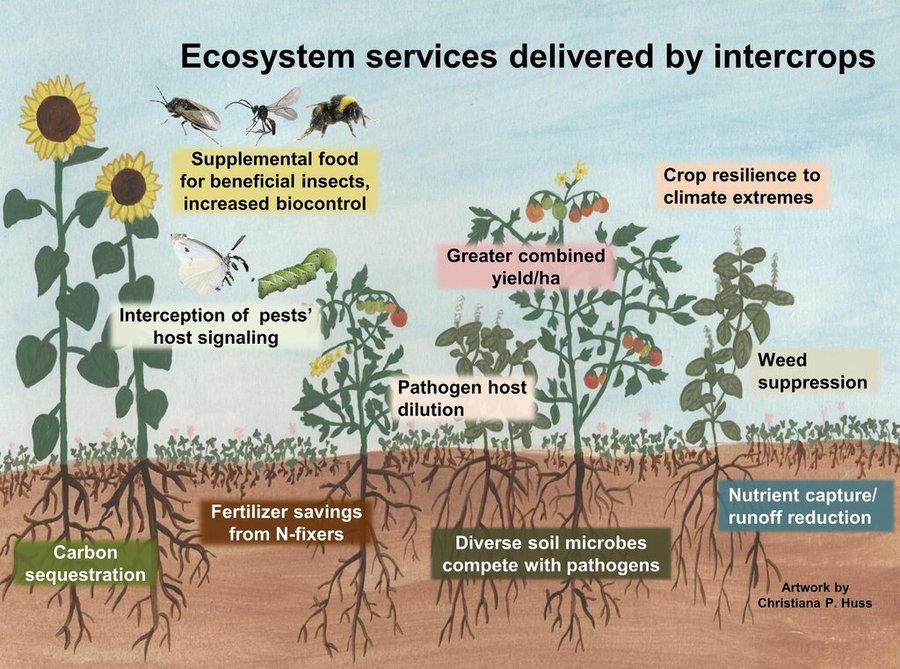
Author: Christiana Huss
Запуск и текущее обслуживание: мероприятия, необходимые ресурсы и затраты
Подсчет вложений и затрат
- Подсчитанные затраты: на площадь, где применяется Технология (размер и единица площади: ha)
- Денежные единицы, использованные для подсчета затрат: CHF
- Обменный курс (к доллару США): 1 USD = 1.13 CHF
- Средний размер дневного заработка для нанятых работников: 240 CHF
Наиболее значимые факторы, влияющие на стоимость затрат
No exceptional investments are needed as existing machines are used.
The cost of seeds and the seed sorting costs by the mills.
Time and labour required for weeding, which can vary based on crop type.
The demand and price for the crops grown. E.g. soy having higher demand and price compared to peas.
Мероприятия, необходимые для начала реализации
n.a.
Текущее обслуживание
-
Mixing seeds: For single tank seeders, mix seeds at a ratio of 80% peas and 40% barley. For multi-tank seeders, apply seeds of mixture partners separately. (Сроки/ повторяемость проведения: Before sowing, typically in late summer.)
-
Sowing: Use a row spacing of 12 cm, and place seeds at a depth of 3 to 4 cm. (Сроки/ повторяемость проведения: late october)
-
Assess the mix’s condition after winter. (Сроки/ повторяемость проведения: Spring, depending on winter severity.)
-
Weed Control: Generally not needed due to the competitive nature of the mixed crop. If high weed pressure: Consider harrowing once (2-3 hours per hectare for weeding). (Сроки/ повторяемость проведения: Spring, depending on winter severity.)
-
Harvesting: Adjust harvester sieves for peas. Open threshing concave and hulling bars wide. Maintain low drum rotation. Monitor for grain loss regularly. Adjust Vario-table to an aggressive cutting angle. (Сроки/ повторяемость проведения: Summer.)
Стоимость вложений и затрат по эксплуатации (per ha)
| Опишите затраты |
Единица |
Количество |
Затраты на единицу (CHF) |
Общая стоимость на единицу (CHF) |
% затрат, оплаченных землепользователями |
|
Оплата труда
|
| Ploughing |
person-days |
1,0 |
200,0 |
200,0 |
100,0 |
| Sowing the Mixture |
person-days |
1,0 |
200,0 |
200,0 |
100,0 |
| Weeding |
person-hours |
3,0 |
23,0 |
69,0 |
100,0 |
|
Оборудование
|
| seeder |
piece |
1,0 |
10000,0 |
10000,0 |
100,0 |
| tractor |
piece |
1,0 |
30000,0 |
30000,0 |
100,0 |
| harvester |
piece |
1,0 |
15000,0 |
15000,0 |
100,0 |
| plough |
piece |
1,0 |
15000,0 |
15000,0 |
100,0 |
|
Посадочный материал
|
| Seed mixture protein peas / barley mixture (autumn sowing) organic |
kg/ha |
200,0 |
6,0 |
1200,0 |
100,0 |
| Общая стоимость поддержания Технологии |
71'669.0 |
|
| Общие затраты на поддержание Технологии в долларах США |
63'423.89 |
|
Природные условия
Среднегодовое количество осадков
-
< 250 мм
-
251-500 мм
-
501-750 мм
-
751-1000 мм
-
1001-1500 мм
-
1501-2000 мм
-
2001-3000 мм
-
3001-4000 мм
-
> 4000 мм
Агроклиматическая зона
-
влажная
-
Умеренно-влажная
-
полузасушливая
-
засушливая
Дополнительные характеристики климата
Среднегодовое количество осадков в мм: 865.0
Название метеостанции: Payerne
average maximum temperature 14.2°C, average minimum temperature 5.1°C
Склон
-
пологие (0-2%)
-
покатые (3-5%)
-
покато-крутые (6-10%)
-
крутые (11-15%)
-
очень крутые (16-30%)
-
чрезвычайно крутые (31-60%)
-
обрывистые (>60%)
Формы рельефа
-
плато/ равнины
-
гребни хребтов/холмов
-
склоны гор
-
склоны холмов
-
подножья
-
днища долин
Высота над уровнем моря
-
0-100 м над уровнем моря
-
101-500 м н.у.м.
-
501-1000 м н.у.м.
-
1001-1500 м н.у.м.
-
1501-2000 м н.у.м.
-
2001-2500 м н.у.м.
-
2501-3000 м н.у.м.
-
3001-4000 м н.у.м.
-
> 4 тыс. м н.у.м.
Технология применяется в
-
в условиях выпуклого рельефа
-
в ситуациях вогнутого рельефа
-
не имеет значения
Мощность почв
-
поверхностные (0-20 см)
-
неглубокие (21-50 см)
-
умеренно глубокие (51-80 см)
-
глубокие (81-120 см)
-
очень глубокие (> 120 см)
Гранулометрический состав (верхнего горизонта)
-
грубый крупнозернистый/ лёгкий (песчаный)
-
средние фракции (суглинистый, супесчаный)
-
тонкодисперсный/ тяжёлый (глинистый)
Гранулометрический состав (на глубине более 20 см)
-
грубый крупнозернистый/ лёгкий (песчаный)
-
средние фракции (суглинистый, супесчаный)
-
тонкодисперсный/ тяжёлый (глинистый)
Содержание органического вещества в верхнем почвенном горизонте
-
высокое (> 3%)
-
среднее (1-3%)
-
низкое (< 1%)
Уровень грунтовых вод
-
на поверхности
-
< 5 м
-
5-50 м
-
> 50 м
Доступность поверхностных вод
-
избыток
-
хорошая
-
средняя
-
недостаточны/ отсутствуют
Качество воды (без обработки)
-
питьевая вода хорошего качества
-
питьевая вода плохого качества (необходима обработка)
-
исключительно для сельскохозяйственного использования (орошение)
-
непригодная для использования
Качество воды относится к: поверхностные воды
Является ли солёность воды проблемой?
Повторяемость затопления
Разнообразие местообитаний
Характеристика землепользователей, применяющих Технологию
Рыночная ориентация
-
натуральное хозяйство (самообеспечение)
-
смешанный (натуральный / коммерческий)
-
товарное/ рыночное хозяйство
Доходы из других источников
-
< 10% всех доходов
-
10-50% всех доходов
-
> 50% всех доходов
Относительный уровень достатка
-
очень плохой
-
плохой
-
средний
-
обеспеченный
-
весьма обеспеченный
Уровень механизации
-
ручной труд
-
тягловая сила
-
механизировано/ есть автотранспорт
Осёдлый или кочевой
-
Осёдлый
-
Полукочевой
-
Кочевой
Индивидуальное или коллективное хозяйство
-
частное/ домовладение
-
группа/ община
-
кооператив
-
использующее наемных работников (компания, государство)
Возраст
-
дети
-
молодёжь
-
средний возраст
-
пожилой
Площадь, используемая домохозяйством
-
< 0,5 га
-
0,5-1 га
-
1-2 га
-
2-5 га
-
5-15 га
-
15-50 га
-
50-100 га
-
100-500 га
-
500-1000 га
-
1000-10000 га
-
> 10000 га
Масштаб
-
мелкое
-
среднего размера
-
крупное
Собственность на землю
-
государственная
-
частной компании
-
общинная/ поселковая
-
коллективная
-
индивидуальная, не оформленная в собственность
-
индивидуальная, оформленная в собственность
Права на землепользование
-
неограниченное (неконтролируемое)
-
общинное (контролируемое)
-
аренда
-
индивидуальное
Права на водовользование
-
неограниченное (неконтролируемое)
-
общинное (контролируемое)
-
аренда
-
индивидуальное
Доступ к базовым услугам и инфраструктуре
занятость (вне хозяйства)
транспорт и дорожная сеть
водоснабжение и канализация
Влияние
Социально-экономическое воздействие
Продуктивность сельскохозяйственных культур
Higher land use ratio (more biomass per hectare).
качество урожая
Cereals in the mixture prevent weeds from spreading within the legumes. But cereals (e.g. barley) of a lower quality than if they were grown in a monoculture.
риск потери продуктивности
If legumes are not growing well, fertiliser can be added and cereals can be harvested.
разнообразие продукции
The same products are harvested as in a monoculture, but at the same time.
площадь, используемая для производства продукции (земли, добавленные в оборот/ пользование)
управление землями
Less intervention (e.g. weeding, fertilisation) required.
потребность в оросительной воде
Water demand remains approximately the same as in monoculture.
сельскохозяйственные издержки
Reduced expenditure on organic crop protection & weeding thanks to cereals' positive effect on weed control (compared to legume monoculture).
доходы хозяйства
As mixed cropping can be used within the crop rotation, it only leads to a slight increase in the farmer's income.
разнообразие источников дохода
The same crops are cultivated as in monoculture.
объем работ
Less intervention (e.g. weeding) required as cereals protect legumes from weeds and legumes provide nitrogen to cereals.
Социальное и культурное воздействие
Экологическое воздействие
испарение
Good soil cover due to mixed cultivation slightly reduces evaporation.
круговорот/ восполнение питательных веществ
Legumes fix nitrogen in the soil.
растительный покров
Slightly higher due to mixed species.
биомасса/ содержание углерода в надземной биомассе
slightly higher because of species mixture
разнообразие флоры
Slightly higher due to mixed species.
инвазивные чужеродные виды
Slightly less due to weed suppression in cereals.
полезные виды (дождевые черви, опылители, некоторые хищники)
Legumes provide flowers for pollinators.
Влияние за пределами территории применения
отложения, переносимые ветром
Анализ эффективности затрат
Насколько получаемый результат сопоставим с первоначальными вложениями
Эффективность затрат в краткосрочной перспективе
крайне отрицательно
очень позитивное
Эффективность затрат в долгосрочной перспективе
крайне отрицательно
очень позитивное
Насколько получаемый результат сопоставим с затратами на техническое обслуживание
Эффективность затрат в краткосрочной перспективе
крайне отрицательно
очень позитивное
Эффективность затрат в долгосрочной перспективе
крайне отрицательно
очень позитивное
Изменение климата
Постепенное изменение климата
сезонные температуры увеличилось
сезонные температуры увеличилось
сезонные температуры увеличилось
сезонные температуры увеличилось
сезонное количество осадков увеличилось
сезонное количество осадков снизилось
сезонное количество осадков снизилось
сезонное количество осадков увеличилось
Экстремальные явления, связанные с изменением климата (стихийные бедствия)
экстремально холодная погода
Внедрение и адаптация
Доля землепользователей (в процентах), применяющих Технологию
-
отдельные случаи/ эксперимент
-
1-10%
-
11-50%
-
> 50%
Среди применяющих Технологию землепользователей, какова доля лиц, применяющих её по собственной инициативе, т.е. без какого-либо материального стимулирования со стороны?
-
0-10%
-
11-50%
-
51-90%
-
91-100%
Была ли Технология УЗП модифицирована в недавнее время с целью адаптации к меняющимся условиям среды?
К каким именно изменяющимся условиям среды?
-
изменения климата/ экстремальные погодные явления
-
изменяющиеся условия рынка
-
доступность рабочей силы (например, из-за миграции населения)
Decrease for market reasons (barley has low market price) & more adapted varieties (pea varieties that are more resistant to wind damage).
Заключительные положения и извлечённые уроки
Сильные стороны: по мнению землепользователей
-
Mixed cropping works very well, providing both legume and cereal yields.
-
Certain crops, like oats, help suppress weeds, reducing the need for additional weeding. Thus saving costs (PPPs & labour) and reducing workload (hours of weeding).
-
Legumes contribute to nitrogen fixation, improving soil fertility for subsequent crops.
-
Mixed cropping reduces the risk of total crop failure, as one crop can compensate if the other underperforms.
Сильные стороны: по мнению составителя или ответственных специалистов
-
If one crop fails, the other can still provide a harvest, ensuring some yield.
-
Mixed cropping can produce more biomass on the same land compared to monocultures.
-
It enhances soil diversity, supports pollinators, and contributes to nitrogen enrichment.
-
Good market price for protein peas. Additionally, the farmer receives a subsidy for grain legumes (including protein peas), if the harvest contains at least 30% grain legume seeds. In addition, the cantons of Jura and Vaud pay cantonal contributions to farmers who cultivate mixed crops. The farmers can also get extra payments by the organic farmer organisation Bio Suisse if certain grain legume species of high demand are cultivated (see Agridea Deckungsbeitrag catalogue for more information).
Слабые стороны/ недостатки/ риски: по мнению землепользователейвозможные пути преодоления
-
Legumes are not growing well due to a cold winter.
Adding fertilizer can help growing the cereal and enables the farmer to still harvest something.
-
Water competition in a dry summer results in a bad crop quality.
Ensure efficient irrigation to reduce competition for water between mixed crops.
-
Barley has a very low market value.
Choose crop varieties that are better adapted to market demands.
Слабые стороны/ недостатки/ риски: по мнению составителя или ответственных специалистоввозможные пути преодоления
-
During drought stress, competition for water between the two crops can occur, leading to potential yield losses or low quality yield.
Use drought-tolerant varieties or species with deep roots for mixed cropping. This can help reduce competition for water and improve resilience during dry periods.
-
Limited market demand for certain crops like barley.
Focus on crops with higher market demand.
-
Need for minimal fertilization in mixed cropping can reduce yield quality of cereals like barley.
Implement targeted fertilization strategies to balance the needs of both crops.
Справочные материалы
Editors
-
Maria Eliza Turek
-
Tatenda Lemann
-
Joana Eichenberger
Рецензент
-
William Critchley
-
Joana Eichenberger
Продолжительность применения Технологии: 22 апреля 2022 г.
Последнее обновление: 10 сентября 2024 г.
Ответственные специалисты
-
Lucien Quillet - землепользователь
-
Matthias Klaiss - Специалист по УЗП
Полное описание в базе данных ВОКАТ
Документирование осуществлялось при участии
Организация
- CDE Centre for Development and Environment (CDE Centre for Development and Environment) - Швейцария
Проект
- OPtimal strategies to retAIN and re-use water and nutrients in small agricultural catchments across different soil-climatic regions in Europe (OPTAIN)
Ключевые ссылки
-
Huss, C. P., Holmes, K. D., & Blubaugh, C. K. (2022). Benefits and risks of intercropping for crop resilience and pest management. Journal of Economic Entomology, 115(5), 1350–1362. https://doi.org/10.1093/jee/toac045:
-
Klaiss, M. (2021). Intercropping of grain pea with cereals (Legumes Translated Practice Note 17, S. 1–4). Institute of Organic Agriculture FiBL. https://orgprints.org/id/eprint/42384/:
-
Alföldi, T., Haug, B., Messmer, M., Goldringer, I., Forst, E., Mary-Huard, T., Enjalbert, J., & Hohmann, P. (2020). Mischkulturen Erbsen/Gerste - Braucht es eine eigene Züchtung? EU-Projekt ReMIX (Video). Forschungsinstitut für biologischen Landbau FiBL, CH-Frick. Retrieved 31 July, 2024, from https://orgprints.org/id/eprint/37276/:
-
Haug, B., Messmer, M., Enjalbert, J., Goldringer, I., Flutre, T., Mary-Huard, T., & Hoh-mann, P. (2023). New insights towards breeding for mixed cropping of spring pea and bar-ley to increase yield and yield stability. Field Crops Research, 297, 108923. https://doi.org/10.1016/j.fcr.2023.108923:
-
Hiltbrunner J., Wüst S., Blatter A., Vonzun S., Klaiss M., Messmer M. (2023). Optimierung des Mischkultursystems Erbse-Gerste zur Sicherung der lokalen Eiweissversorgung. Feld-rundgänge & Präsentation Projekt PROMISE 2023. Agroscope. Stiegenhof, Arenenberg, Utzenstorf & Sargans. https://ira.agroscope.ch/de-CH/publication/53643:
-
Vonzun S., Blatter A., Wüst S., Hiltbrunner J., Schneider M., Messmer M. (2023). Investi-gating mixed cropping systems with pea and lentils for climate-smart and demand oriented agriculture. Fourth International Legume Society Conference 2023. 19 September, Granada. https://ira.agroscope.ch/de-CH/publication/55455:
Ссылки на материалы по теме, доступные онлайн











